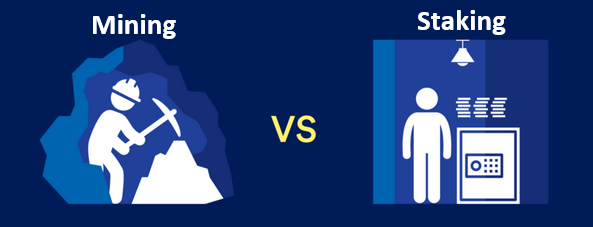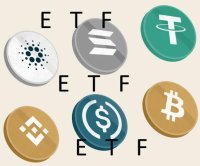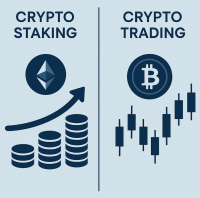The choice depends on technical expertise, available capital, and risk tolerance, with staking generally offering more consistent, lower-risk returns and mining offering higher but more volatile potential rewards.
1. Mining vs. Staking: Profitability & Trade-Offs
- Staking offers generally consistent, passive yields with lower operational risk and complexity, though returns are modest - typically single-digit APYs. It’s also becoming increasingly popular: over 60 % of new crypto projects in 2025 prefer staking models.
- Mining, by contrast, can yield higher profit potential but comes with greater setup complexity, hardware costs, and operational challenges. For instance, recent commentary on Bitcoin mining notes that profitability now hinges significantly on access to low-cost electricity and operational control.
- A comparative framework (mid-2025) shows staking yields like Ethereum (~3 %), Solana (6–7 %), Cardano (4–6 %), Cosmos (up to ~18 %, net ~6 %), NEAR (9–11 %), offering steady but moderate income.
- Summary:
- Choose staking for steady, low-management income and lower upfront cost.
- Choose mining only if you're equipped to manage infrastructure and energy costs - but it can be more potentially profitable.
2. Crypto Mining Methods
Crypto mining can employ different hardware depending on the algorithm:
- ASIC (Application-Specific Integrated Circuit): Ultra-efficient devices for specific algorithms.
- Used for Bitcoin (SHA-256), Litecoin (Scrypt), Dash (X11), etc.
- GPU (Graphics Processing Unit): Flexible and powerful for many altcoins.
- Popular for Ethereum Classic, Ravencoin (KAWPOW), Zcash (Equihash), Grin (Cuckatoo/Cuckaroo).
- CPU (Central Processing Unit): Least powerful but accessible.
- Primarily for ASIC-resistant coins like Monero (RandomX), Ravencoin, Vertcoin.
3. Top 5 Cryptocurrencies to Mine (2025)
According to current sources that rank mining options by profitability and accessibility:
- Bitcoin (BTC) – Highest block rewards, but requires expensive ASICs and large electricity. Still profitable for well-capitalized operations.
- Monero (XMR) – Privacy-oriented; ASIC-resistant; can be mined with CPU/GPU; accessible to at-home miners.
- Litecoin (LTC) – Scrypt-based; can use ASICs; simpler than BTC; solid reputation.
- Zcash (ZEC) – Privacy coin; mineable with GPU or ASIC; moderate difficulty.
- Dogecoin (DOGE) – Scrypt-based, often mined alongside Litecoin; medium difficulty.
4. Top 5 Cryptocurrencies to Stake (2025)
Based on current yields and overall network robustness:
Traditional, established networks:
- Ethereum (ETH) – 3–6 % APY depending on platform
- Solana (SOL) – Around 6–7 % APY
- Cardano (ADA) – Typically 4–6 % as a delegated PoS network
- Cosmos (ATOM) – Up to 18 % (net ~6 % via exchanges)
- Polkadot (DOT) – Real reward rate ~6.1 %
High-yield, newer/presale projects (high risk):
- ** Bitcoin Hyper (HYPER)** – advertised APYs up to 480 %
- Maxi Doge – offering up to 660 % APY
- TOKEN6900 – ~607 % APY
5. Mining vs. Staking: Quick Comparison
6. Final Thoughts
- If you value simplicity and reliability, staking top networks like ETH, SOL, ADA, ATOM, or DOT is the safer long-term choice.
- If you're equipped with mining hardware and low electricity costs, mining major coins like BTC, XMR, LTC, ZEC, or DOGE can still be profitable - though it demands more active management.
- High-APY presale projects like Bitcoin Hyper, Maxi Doge, or TOKEN6900 may offer explosive upside - but come with massive risk and should be approached with caution.








